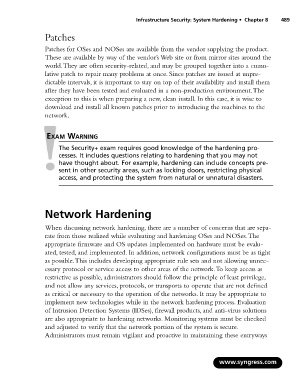Page 505 - StudyBook.pdf
P. 505
Infrastructure Security: System Hardening • Chapter 8 489
Patches
Patches for OSes and NOSes are available from the vendor supplying the product.
These are available by way of the vendor’s Web site or from mirror sites around the
world.They are often security-related, and may be grouped together into a cumu-
lative patch to repair many problems at once. Since patches are issued at unpre-
dictable intervals, it is important to stay on top of their availability and install them
after they have been tested and evaluated in a non-production environment.The
exception to this is when preparing a new, clean install. In this case, it is wise to
download and install all known patches prior to introducing the machines to the
network.
EXAM WARNING
The Security+ exam requires good knowledge of the hardening pro-
cesses. It includes questions relating to hardening that you may not
have thought about. For example, hardening can include concepts pre-
sent in other security areas, such as locking doors, restricting physical
access, and protecting the system from natural or unnatural disasters.
Network Hardening
When discussing network hardening, there are a number of concerns that are sepa-
rate from those realized while evaluating and hardening OSes and NOSes.The
appropriate firmware and OS updates implemented on hardware must be evalu-
ated, tested, and implemented. In addition, network configurations must be as tight
as possible.This includes developing appropriate rule sets and not allowing unnec-
essary protocol or service access to other areas of the network.To keep access as
restrictive as possible, administrators should follow the principle of least privilege,
and not allow any services, protocols, or transports to operate that are not defined
as critical or necessary to the operation of the networks. It may be appropriate to
implement new technologies while in the network hardening process. Evaluation
of Intrusion Detection Systems (IDSes), firewall products, and anti-virus solutions
are also appropriate to hardening networks. Monitoring systems must be checked
and adjusted to verify that the network portion of the system is secure.
Administrators must remain vigilant and proactive in maintaining these entryways
www.syngress.com

